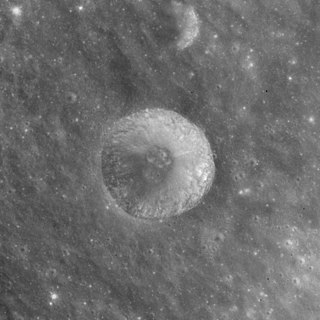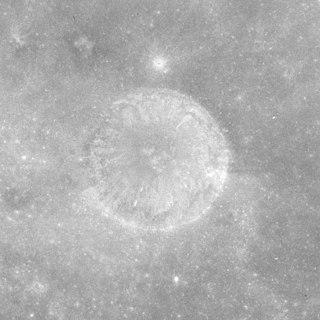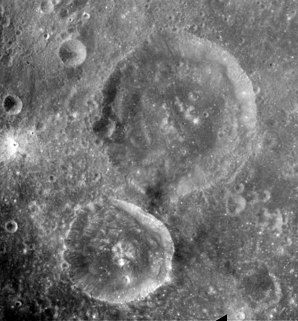
Al-Marrakushi is a small, relatively isolated lunar impact crater in the eastern Mare Fecunditatis. It is a circular, symmetrical formation, with inner walls that slope down to the midpoint. To the northeast is the prominent crater Langrenus. The mare near Al-Marrakushi is marked by ray material from its larger neighbor.

Acosta is a small lunar impact crater located just to the north of the prominent crater Langrenus, near the east edge of Mare Fecunditatis. To the west are the trio of Atwood, Naonobu, and Bilharz. Acosta is named after the Portuguese naturalist Cristóvão da Costa.

Avery is a small lunar impact crater located near the eastern limb of the Moon. This is a circular, bowl-shaped formation with a small interior floor. It lies near the western edge of Mare Smythii. To the east is the crater Haldane, and to the southwest is Carrillo. Gilbert lies to the southwest.

Born is a small lunar impact crater located near the eastern edge of the Moon, to the northeast of the prominent crater Langrenus. It was previously designated Maclaurin Y before being named by the IAU in 1979. Maclaurin itself lies to the north.

Brewster is a small lunar impact crater in the northern fringes of Sinus Amoris. It was named after the Scottish scientist, Sir David Brewster. Its diameter is 9.8 km. It lies to the southwest of the larger crater Römer. To the southeast of Brewster is the similar-sized Franck. This crater is cup-shaped and symmetrical, with no overlapping craters of note. A low ridge is attached to the northern rim. The crater interior has a relatively high interior albedo compared to the surrounding terrain.

Clerke is a tiny lunar impact crater named after Irish astronomer Agnes Mary Clerke, who played a role in bringing astronomy and astrophysics to the public in Victorian England. It is located near the eastern edge of Mare Serenitatis in the midst of a rille system named the Rimae Littrow after the crater Littrow to the east. It is roughly circular and cup-shaped, with a relatively high albedo. In a valley to the southeast is the landing site of the Apollo 17 mission. Clerke was previously designated Littrow B.

Littrow is a lunar impact crater that is located in the northeastern part of the Moon's near side, on the east edge of Mare Serenitatis. Its diameter is 29 km. The crater is named after Bohemian astronomer Joseph Johann Littrow. Some distance to the northeast is the prominent crater Römer, while to the south is Vitruvius.

Atwood is a small earth moon impact crater that is located on the Mare Fecunditatis, to the northwest of the prominent crater Langrenus. It forms a triple-crater formation with Naonobu attached to the north rim and Bilharz near the west rim.

Back is a small lunar impact crater that is located near the eastern limb of the Moon. It lies on the northwest edge of the Mare Smythii, and the northeast rim is adjacent to the crater Schubert. To the west is Jenkins, and to the southwest is the Weierstrass–Van Vleck crater pair.

Barkla is a lunar impact crater that lies near the eastern limb of the Moon. It is located to the east of the prominent crater Langrenus, and was formerly designated Langrenus A before being renamed by the IAU in 1979. Due east of Barkla is Kapteyn, a formation only slightly larger with a similar size. Southwest of Barkla is the crater Lamé.

Cusanus is a lunar impact crater that is located near the northeastern limb of the Moon. In this location the crater appears very foreshortened when observed from the Earth, and its visibility is affected by libration. The northern rim of Cusanus is nearly joined to the south-southeastern rim of the larger crater Petermann. To the west is Baillaud and to the southeast is Hayn.

Dollond is a small lunar impact crater that is located in the central region of the Moon, to the north of the crater Abulfeda. It was named after British optician John Dollond. Due west of Dollond is Anděl. Dollond is circular and cone shaped, with a tiny floor at the midpoint of the sloping interior walls.

Eckert is a tiny, isolated lunar impact crater in the northern part of the Mare Crisium. This crater forms a circular pit in the dark surface of the surrounding lunar mare. Just to the west is a wrinkle ridge in the mare surface, a feature that is prominent only under oblique lighting from the Sun. The nearest craters of note are Peirce to the west-northwest, and Picard to the southwest. Both of these craters lie in the Mare Crisium basin.

Bondarenko is a lunar impact crater on the far side of the Moon. It is located to the northeast of the large, dark-floored crater Tsiolkovskiy, and south of the crater Chauvenet. This is a worn crater formation with an irregular floor, similar to other craters in the area, which are covered by ejecta from Tsiolkovskiy.

Robert is a tiny lunar impact crater in the southeastern part of the Mare Serenitatis. It is located to the northeast of the small crater Dawes, and to the west of the Montes Taurus range. To the east-northeast of this position is the landing site of the Apollo 17 mission, in the Taurus–Littrow valley.

Fleming is a large lunar impact crater that is located on the Moon's far side, and cannot be seen from the Earth. It lies about a crater diameter to the east-northeast of Hertz, and to the northwest of Lobachevskiy.

Florensky is a lunar impact crater that is attached to the northeastern rim of the larger crater Vernadskiy. It is located on the far side of the Moon and cannot be directly seen from the Earth. The rim of this crater has been heavily eroded and it forms an irregular ring about the uneven interior. This crater was previously identified as Vernadskiy B before being assigned a name by the IAU in 1985.

Stella is a small lunar impact crater on the eastern side of Mare Serenitatis. It is a fresh crater with a prominent bright ray system. It is to the southwest of the larger Ching-Te, and west of the Taurus-Littrow valley where Apollo 17 landed in 1972.

Jerik is a tiny lunar impact crater in the southeastern part of the Mare Serenitatis. It is located to the northeast of the small crater Dawes, and to the west of the Montes Taurus range. To the east-northeast of this position is the landing site of the Apollo 17 mission, in the Taurus–Littrow valley.

Mary is a tiny lunar impact crater in the southeastern part of the Mare Serenitatis. It is located to the northeast of the small crater Dawes, and to the west of the Montes Taurus range. To the east-northeast of this position is the landing site of the Apollo 17 mission, in the Taurus–Littrow valley.






















